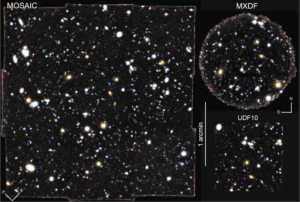An overview of the science cases is presented in the updated version of the BlueMUSE White paper, presented at the Phase A review and available here for download.
BlueMUSE , designed as a sister instrument to MUSE, is an integral-filed spectrograph (IFS) covering one squared arcmin field-of-view (FoV) and capable of accessing the blue wavelength range (350- 580nm) observable from the ground. It will work within the concept of “spectroscopy of everything”, providing a spectrum for any object with the FoV. Observational astronomy in the optical/near infrared wavelengths of the next decade will be characterised by large-scale projects focusing on imaging surveys of the sky: Euclid, Rubin/LSST and Roman. They will provide an unprecedented number of targets and events that will require spectroscopic follow-up.
BlueMUSE is envisioned both as a “discovery” and a “follow-up” instrument. In the former role, through its “spectroscopy of everything” approach, it will provide targets to other instruments to be observed at higher spatial resolution, greater depth or at other wavelengths. In the latter role it will provide spectroscopic coverage in the blue of extended regions on the sky (or large numbers of targets). BlueMUSE will both open up a new range of galactic and extragalactic science cases, and offer a strong synergetic potential for instruments at the ELT.

Figure 1. Pseudo-colour images of three MUSE deep fields (Bacon et al. 2023). BlueMUSE will be about 16 times more efficient in observing such deep fields at 2<z<3 due to lower cosmological surface brightness dimming compared with MUSE (covering 3<z<5).
BlueMUSE science cases are split in three groups, mapping astronomical objects and processes from the Solar System to the Distant Universe. Each group is led by a Key Science Case, which is uniquely adapted to BlueMUSE. In addition, there are several more general science cases that strongly benefit from BlueMUSE characteristics and design. The following list in not exhaustive, but presents a selection of science cases that demonstrate the properties of BlueMUSE, its versatility and capability to address the challenges of astrophysical research in 2030s.
